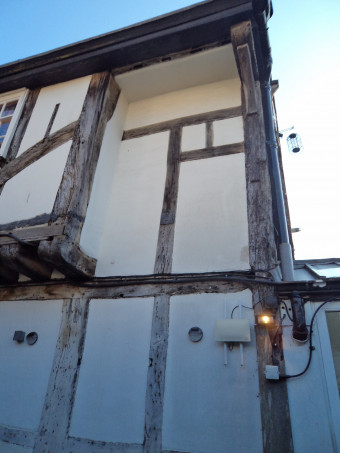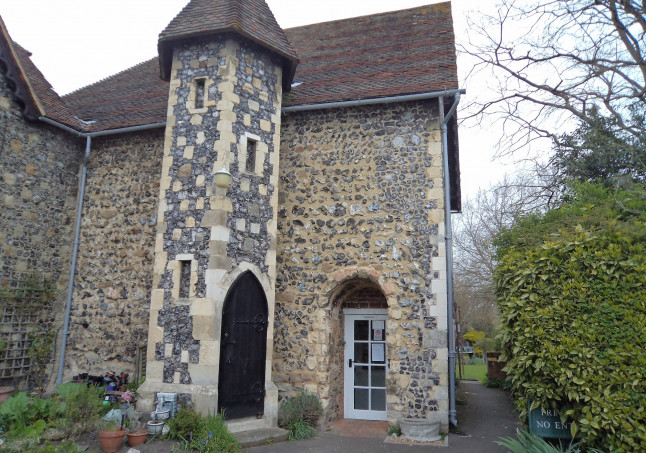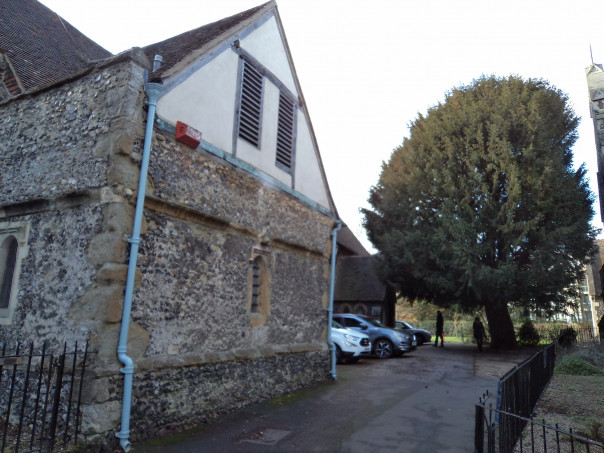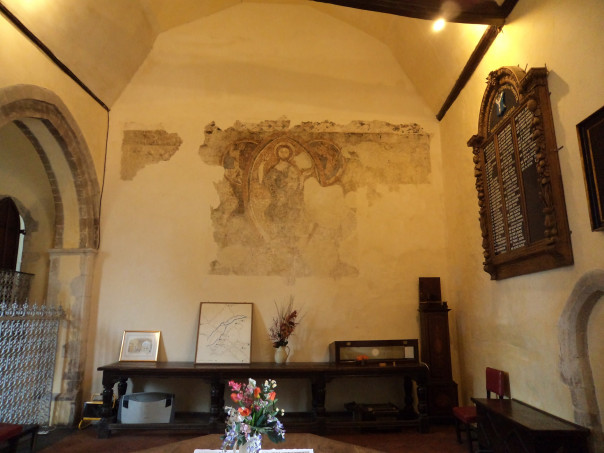Before I mention two events Dr Diane Heath is holding in the very near future, I thought I would again flag up the dates for the Tudors & Stuarts 2023 history weekend because I am hoping to be able to announce that the box office is open at the beginning of December. Please do keep an eye out for this announcement and the dates for a great programme are Friday 28 April to Sunday 30 April with speakers including Professors Alec Ryrie, Vanessa Harding, Steven Gunn and Catherine Richardson.

Now to Diane’s events, on Saturday 26 November, as part of the NHLF-funded ‘Medieval Animals Heritage’ project, she and her team of helpers, including several student volunteers, will be holding a pre-Christmas celebration for SEND children and their families at Canterbury where all can engage in a fun, open-ended Christmas crafts on a medieval animals theme extravaganza … from splatter-snow card and sparkly bell making, to creating a festive hat or fabulous beast tree decoration. To help the festivities along, there will be party food and games, and a quiet room to relax between activities. As you can imagine, this is proving to be very popular, and all the free tickets have been taken already.
Then on Monday 28 November, Diane has her second ‘Amulets’ event at the Science Museum in London. Again, the focus will be conversations among the various experts who are attending, as well as presentations by Drs Kathleen Walker-Meikle, Vicki Blud, Lucy Allen, Catriona Cooper (CCCU) and Diane. This is another exciting development as they work towards putting together an application to the AHRC.

Due to the particular circumstances of this week, I’m going to hold over the report from the Kent History Postgraduates catch up meeting this Wednesday until next week and instead take another topical subject that might equally be said to echo matters from the past. I am borrowing from my 2020 article in the Kent Archaeological Society’s annual journal, Archaeologia Cantiana, currently only available to members, and if it sounds interesting and you want to read more as well as lots of fascinating articles on Kent’s history and archaeology, you might like to take a look here: https://kentarchaeology.org.uk/ and perhaps think about joining – free to students still, I believe.
The subject of this article was ‘community care’ as provided by charitable institutions at the Kentish Cinque Ports in the Middle Ages, and as I noted, the role taken by government, especially local civic authorities, in caring for the vulnerable within society is again under the spotlight in twenty-first-century Britain. Indeed, perhaps even more so in late 2022 than it was three years ago when I wrote the piece because of the greater squeeze on local government budgets and the price rises all are experiencing.
With regard to the article, the point I was making was that 600-years ago rather than the government being under scrutiny concerning hospitals as charitable foundations, it was the Church that was at fault according to reformers. For John Wycliffe and his Lollard followers raised considerable controversies in Richard II’s reign regarding what they saw as the need to disendow the Church and the unjust relationship between benefactions to friars and almsgiving to the poor in late medieval society. According to the Lollards, hospitals were key to helping the poor whose miseries were not their own fault, those Professor John Henderson labelled the episodic (elderly and chronically sick), epidemic (those suddenly forced below subsistence level due to severe dearth or epidemic disease) and endemic (life-cycle poverty) poor, provided these establishments were taken out of the Church’s control. Moreover, during the 1410s the same issues were raised again on several occasions in and around Parliament, including the call to disendow the Church and establish a hundred new almshouses, each with an income of a hundred marks to be used to feed the poor inmates, the management of these new almshouses to be the responsibility of ‘good and true secular persons’.

This idea that hospitals in the Middle Ages were run by the Church was not only held by contemporaries, but still pervades much of the modern studies on these institutions, and in some cases is correct. However, there were civic-governed hospitals across England before the battle cry raised by the Lollards and Kent had a decent number of these establishments, especially in the Cinque Ports.
For the purposes of the article, I looked first at foundation and early history before turning to the 15th and 16th centuries, because in probably three of the four Kentish Head Ports by the late fourteenth century (Hythe, New Romney and Sandwich) there were such charitable institutions which were intended for the care of poor people as categorised by Wycliffe. For the civic authorities, this meant that they were able to demonstrate social responsibility and good governance, while the hospital brothers and sisters, in exchange for a personal allowance, as well as certain items in common, were engaged primarily in communal activities for the maintenance of their hospital, rather than spiritual duties for the souls of the hospital’s benefactors, even though the latter duties were not to be forgotten. Consequently, when not at their prayers, those at the Hythe hospital were expected to work on craft or other activities. At St Bartholomew’s in Sandwich the sisters were to work in the dairy, brewhouse and bakehouse, the brothers engaged on the hospital’s home farm, while at St John’s the brothers collected alms in cash and kind in the town and more occasionally further afield, the sisters perhaps tending the hospital’s gardens, washing and caring for the poor and infirm who were accommodated for short periods in 3 rooms at the hospital.

As I discussed, this situation did not last at New Romney, the town jurats seemingly allowing their hospital to decline over the later 15th and 16th centuries, but did remain important at Hythe and Sandwich, albeit the evidence is better for the latter, not least because of the survival of the admissions’ book for St John’s hospital there. So, for the purposes here I’m just going to highlight one of the areas this remarkable document can tell us about the relationship between the governors and the governed in this hospital setting.
Firstly, the register indicates how through visitations the civic authorities kept close oversight of St John’s hospital, the mayor, often accompanied by two jurats and the common clerk, witnessing the entry of a new brother or sister. Due to the nature of these visitations, their frequency varied annually and between 1400 and 1510 no visitations were conducted in fourteen years (13%). Nevertheless, in over 62% of the years in this period between one and three visitations per annum took place, and in the remaining years they were even more frequent, including six years when there were either eight or nine visits each year. This peak occurred between the mid-1440s and the late 1450s, which may reflect a difficult period for the hospital and the town more broadly, although there was a more minor rise in the mid-1430s and immediately after 1500.
As well as providing an idea regarding the civic authorities’ concern that the correct procedures were enacted at the oath-taking, these events and their recording in the hospital’s register, perhaps by the town’s common clerk, suggest that respective mayors were also keen to ensure the new inmate paid his or her fee. Such concerns may in part reflect the relatively precarious nature of the hospital’s finances because it had comparatively little property, much of it from the early fifteenth century on long-term lease, and other income was probably heavily reliant on casual alms and testamentary bequests. Most entry fees were paid in cash, sometimes specifically allocated towards repairing the hospital. Yet payment in kind, building materials or labour, was accepted occasionally. For example, two new sisters in the early 1460s gave in total 3,000 tiles, and on rare occasions in the mid-century a mattress and items of bedding were seen as sufficient, but whether it was the civic authorities or the master who sanctioned such cases is not stated. However, it seems more likely that the mayor claimed this authority, and similarly the amount and conditions of payment, which meant the civic authorities were acutely aware of the decline in the level of entry fee collected over the century, a problem compounded by the growing number of brothers and sisters who sought to pay by instalments.

I don’t have room here to discuss other aspects of the admissions’ register’s value – see the article, but just to say it is perhaps even more significant for what it tells us about the lives of individual brothers and especially the sisters, because women’s lives are rarely visible in the sources. Now if you want to read about that, it is available at: https://kentarchaeology.org.uk/arch-cant/vol/123/joining-sisters-female-inmates-late-medieval-hospitals-east-kent
Finally, I want to draw your attention to a recent addition by Michelle Crowther to Professor Carolyn Oulton’s Kent Maps Online project: https://www.kent-maps.online/medieval/medieval-canterbury and if you are in Canterbury, I would recommend visiting St Mildred’s church – a gem even if you can only see the outside: https://www.canterbury.ac.uk/arts-and-humanities/research-kent-history-and-archaeology/crkha-latest-projects/st-mildreds-church-canterbury.aspx and I would like to thank the staff at Siesta who have been unfailingly welcoming to people going into their shop to stare at the beams to see the Roman numerals – as you go in look up and to your left towards the end of each beam.
 Centre for Kent History and Heritage
Centre for Kent History and Heritage Sheila Sweetinburgh
Sheila Sweetinburgh 967
967

